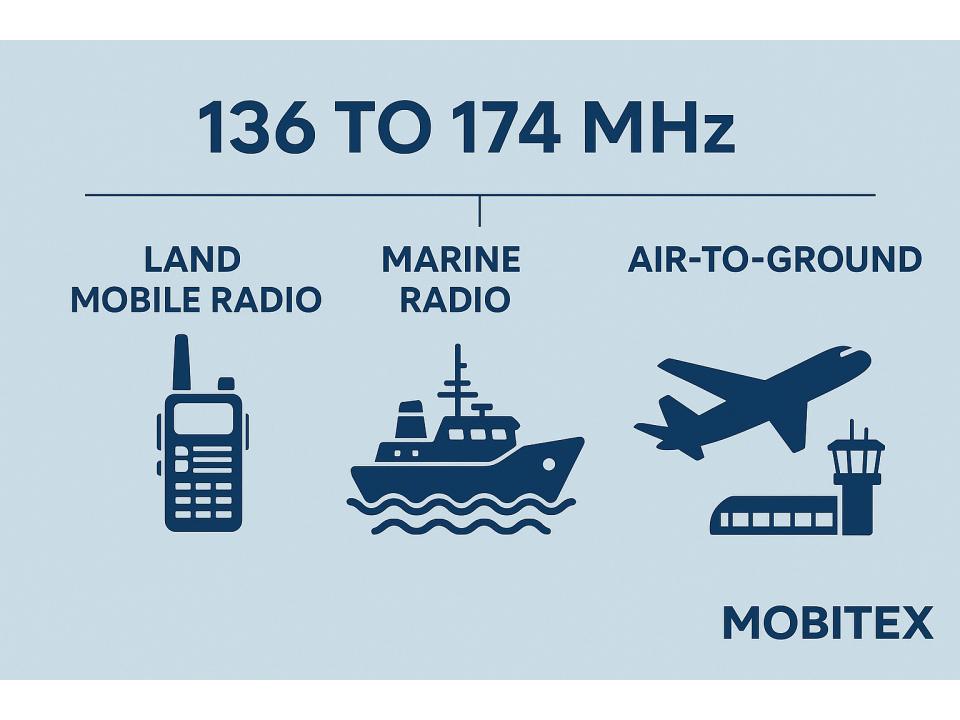Frequency
163 MHz
Range
148–174 MHz
Band Group
VHF (30–300 MHz)
🌐 Summary
The 163 MHz allocation is part of the VHF (30–300 MHz) spectrum. This range is used worldwide for critical applications that keep our communications and infrastructure running smoothly. On this page we highlight how each band is applied in real systems, from regulatory assignments to everyday devices. Our goal is to make spectrum data clear and practical for engineers, regulators, and enthusiasts alike.
Key uses of this band include: 163 MHz: Marine VHF, Land Mobile; Public safety radios, business radios; weather alerts/broadcast; vessel tracking.
VHF‑High land mobile radio (≈162–174 MHz): public safety, forestry, railroads, telemetry.

🔍 Explore the full RF Spectrum database
📡 Band & Geometry key
| Field | Value |
|---|---|
| Wavelength (m) | 1.84 |
| Waveforms | – |
| Antenna Form Factor (Typical) | ¼-wave ≈ 46.0 cm |
| Band Family | LMR/Public Safety |
| Band | Land mobile / Fixed (VHF high) |
| Primary Common Name | Land mobile / Fixed (VHF high) |
| FSPL @ 1 km [dB] | 76.683752088079 |
| FSPL @ 10 km [dB] | 96.683752088079 |
| Fresnel Radius @ 1 km (m) | 21.449841619962 |
| Band Group | VHF (30–300 MHz) |
| Tax Band Family | VHF |
| Tax Band Class | VHF Band |
🧩 Applications & Usage
| Field | Value |
|---|---|
| Primary Application | – |
| Lower Neighbor Use | 2 m Amateur (R2/R3); Land mobile (R1) |
| Upper Neighbor Use | Broadcasting (VHF TV) |
| Typical Services Devices | Marine VHF, Land Mobile |
| Market Common Devices | Public safety radios, business radios |
| Refarming Use | No |
| Device Ecosystem Size | Medium |
| Device Hotspots (MHz) | 155, 162, 168 |
| Device Category | NOAA Weather Radio; AIS (Maritime) |
| Typical Use Cases | weather alerts/broadcast; vessel tracking |
| Modulation (Device) | FM (narrow); GMSK |
| Channel Width (Device) [kHz] | 25 |
| Device Region Profiles | US/Canada; Global maritime VHF |
| Per-Region EIRP Or Duty (Device) | Continuous broadcast; Shipborne power; regulated |
| Allocation Relevance (Device) | Weather information services; Marine VHF allocation |
| Adjacent-Band Collision Risks (Device) | Adjacent VHF services; Nearby NWR/other VHF users |
| Example Devices Or Skus | VHF Public Safety Radios, Marine Radios |
| Common Protocols | Analog FM (12.5 kHz); DMR; P25 (region); TETRA (region) |
🗒️ Notes
| Field | Value |
|---|---|
| Receiver Selectivity Notes | ≥60 dB @ ±12.5 kHz |
| Interference Notes | Internationally coordinated, distress frequencies |
| Compatibility Risk Notes | – |
| Notes | VHF‑High land mobile radio (≈162–174 MHz): public safety, forestry, railroads, telemetry. |
| Propagation Notes | Strong coverage, good indoor penetration |
⚙️ Technical Rules
| Field | Value |
|---|---|
| Lower Band Frequency Limit | 148 |
| Upper Band Frequency Limit | 174 |
| EIRP Indoor Limits | N/A (licensed; verify national rules) |
| EIRP Outdoor Limits | N/A (licensed; verify national rules) |
| PSD Limit | — |
| Emission Mask Class | LMR 12.5 kHz NB |
| Guardband Minimum [kHz] | 12.5 |
| Typical Bandwidths | 11–20 kHz |
| Autocalculated Bandlimits | No |
| Typical Bandwidths (Estimated) | 11–20 kHz |
| Max EIRP [dBm] | Continuous broadcast; Shipborne power; regulated |
| Power Source Or Duty Profile (Typical) | Mains receivers; battery backup; Mains/ship power |
| Channelization Plan | – |
| Channelization | – |
| Guard Band Requirement | – |
| OOB Emission Limit [dBm/MHz] | -13 (baseline) |
| Spurious Emission Limit (dBm) | -30 (baseline) |
| RX Blocking Min [dBm] | -15 (planning) |
| Duplexing | Half-duplex |
| Duplexing Information | Simplex or paired allocations |
| Uplink Pairing | – |
| Downlink Pairing | – |
| Paired Band Info | – |
| Max EIRP [dBm] | – |
| Channelization Block Size | 12.5 / 25 kHz channels |
| 3GPP Band Number | |
| Example 3GPP Bands | – |
| LTE Uplink Bands | – |
| LTE Downlink Bands | – |
| NR Uplink Bands | – |
| NR Downlink Bands | – |
| Guard Bands | Channel guard bands |
| Protocol Or Standard | NWR; AIS |
🌎 Country Overrides
| Field | Value |
|---|---|
| Tax Service Category | Other / Various |
| Tax License Type | Licensed / Service-Specific |
| Tax Regions | Global / Varies |
| ITU Region 1 | Land mobile, Fixed |
| ITU Region 2 | Land mobile, Fixed |
| ITU Region 3 | Land mobile, Fixed |
| License Type | Land mobile / Fixed service (licensed, often public safety/commercial) |
| Primary Application | – |
| Primary Services | – |
| Spurious Emission [dBm] | -30 (baseline) |
| Lower Neighbor Use | 2 m Amateur (R2/R3); Land mobile (R1) |
| Upper Neighbor Use | Broadcasting (VHF TV) |
| Licensing Model | Licensed (Maritime/Land) |
| Typical Services Devices | Marine VHF, Land Mobile |
| US FCC Alloc | Land Mobile (Part 90/95)– |
| CA IC Alloc | Land Mobile (RSS-119)– |
| UK Ofcom Alloc | PMR/Business Radio (LMR)– |
| US Ref | 47 CFR Part 90 (Private Land Mobile) |
| Typical Bandwidths | 11–20 kHz |
| Market Licensing Model | Licensed (LMR) |
| Market Common Devices | Public safety radios, business radios |
| Fresnel Radius (1st, 1 km) [m] | 21.449841619962 |
| Typical Bandwidths (Estimated) | 11–20 kHz |
| Auction Status | – |
| Refarming Use | No |
| Typical Site Spacing km | 5 / 30 |
| Device Ecosystem Size | Medium |
| Traffic Load Share | Coverage-heavy, low capacity share |
| Device Hotspots (MHz) | 155, 162, 168 |
| Device Category | NOAA Weather Radio; AIS (Maritime) |
| Typical Use Cases | weather alerts/broadcast; vessel tracking |
| Typical Center Frequencies [MHz] | 162.400–162.550; 161.975 / 162.025 |
| Rule Part (Fcc Or Region) | FCC broadcast rules; ITU-R M.1371; national maritime rules |
| Modulation (Device) | FM (narrow); GMSK |
| Channel Width (Device) [kHz] | 25 |
| Device Region Profiles | US/Canada; Global maritime VHF |
| Per-Region EIRP Or Duty (Device) | Continuous broadcast; Shipborne power; regulated |
| Allocation Relevance (Device) | Weather information services; Marine VHF allocation |
| Adjacent-Band Collision Risks (Device) | Adjacent VHF services; Nearby NWR/other VHF users |
| Example Devices Or Skus | VHF Public Safety Radios, Marine Radios |
| Antenna Form Factor (Typical) | ¼-wave ≈ 46.0 cm |
| Power Source Or Duty Profile (Typical) | Mains receivers; battery backup; Mains/ship power |
🛡️ Regulatory & Neighbors
| Field | Value |
|---|---|
| Lower Band Frequency Limit | 148 |
| Upper Band Frequency Limit | 174 |
| Rx Blocking Min dBm | -15 (planning) |
| Lower Neighbor Use | 2 m Amateur (R2/R3); Land mobile (R1) |
| Upper Neighbor Use | Broadcasting (VHF TV) |
| Lower Neighbor Band | 2 m Amateur (R2/R3); Land mobile (R1) |
| Lower Neighbor Range | 147.000–148.000 MHz |
| Upper Neighbor Label | Broadcasting (VHF TV) |
| Upper Neighbor Range | 175.000–215.000 MHz |
| Adjacent-Band Collision Risks (Device) | Adjacent VHF services; Nearby NWR/other VHF users |
| Real-World Range (Indoor/Outdoor) | Tens of km from transmitters; Line-of-sight tens of km sea-level; more with mast height |
| US FCC Alloc | Land Mobile (Part 90/95)Land Mobile (Part 90/95) |
| CA IC Alloc | Land Mobile (RSS-119)Land Mobile (RSS-119) |
| UK Ofcom Alloc | PMR/Business Radio (LMR)PMR/Business Radio (LMR) |
| Regulatory References | US: 47 CFR Part 90 (Private Land Mobile); CA: ISED RSS‑119 (Land Mobile 27.41–960 MHz); UK: Ofcom PMR/Business Radio (UK FAT) |
| Global Harmonization | Regional |
| Crossborder Coordination | High |
| Sharing Mechanism | – |
| Auction Status | – |
| Guard Or Pair | – |
📈 Market & Measurements
| Field | Value |
|---|---|
| Noise Floor | -105 dBm (est.) |
| Interference Cases | – |
| Lower Neighbor Range | 147.000–148.000 MHz |
| Upper Neighbor Range | 175.000–215.000 MHz |
| Interference Notes | Internationally coordinated, distress frequencies |
| Market Licensing Model | Licensed (LMR) |
| Market Commercial Value | Medium |
| Market Common Devices | Public safety radios, business radios |
| Market Deployment Density | Dense in urban PS networks |
| Noise Floor (Estimated) | -105 dBm (est.) |
| Market Commercial Value (Estimated) | Medium |
| Ecosystem Maturity | Emerging |
| Indoor Penetration | Good |
| Known Interference | No major interference issues noted |
| Device Ecosystem Size | Medium |
| Real-World Range (Indoor/Outdoor) | Tens of km from transmitters; Line-of-sight tens of km sea-level; more with mast height |
| Antenna Form Factor (Typical) | ¼-wave ≈ 46.0 cm |
| Ecosystem Maturity | Emerging |
| Device Ecosystem Size | Medium |
| Chipset Availability | Limited / TBD |
| Operator Deployments | Limited operators |
| Technology Generations Deployed | Multiple / TBD |
| Roaming Support | – |
| Traffic Load Share | Coverage-heavy, low capacity share |
| Indoor Penetration | Good |
| Known Interference | No major interference issues noted |
| Occupancy | Medium |
| Occupancy Bucket Pct | 10–30% |
| Latency Profile | – |
| Common Channels Or Profiles | 7 standard NWR channels; AIS 1 / AIS 2 |
| Security Features | SAME alert coding; N/A |
| Lbt Or Fhss Requirement | N/A; TDMA scheme |
| Popularity (Installed Base) | High; High on waterways |
| Coexistence Tips | Outdoor antennas for fringe reception; Keep antenna high/clear; avoid intermod on mast |
| Latency Class | Broadcast; Interactive/TDMA |
| Device Hotspots (Scoped && Tagged) | – |

